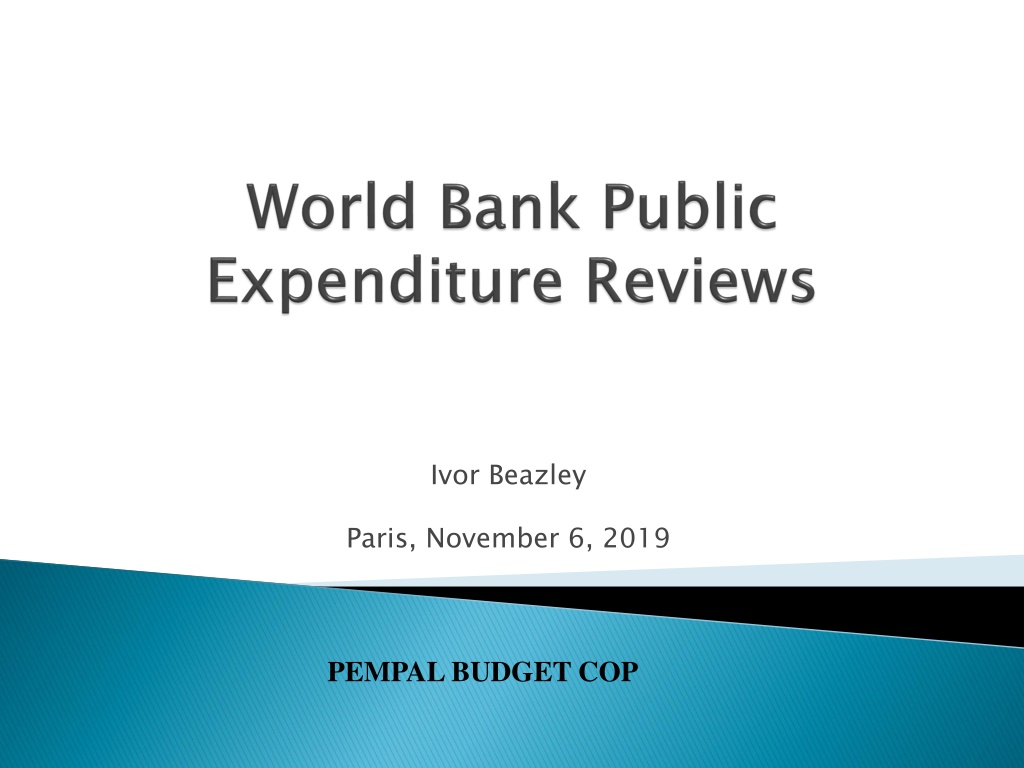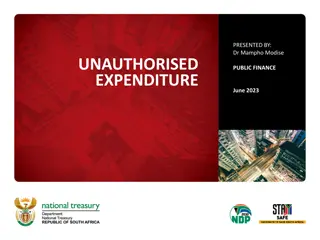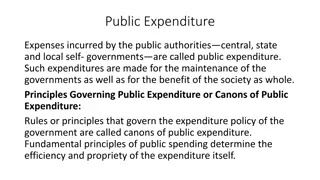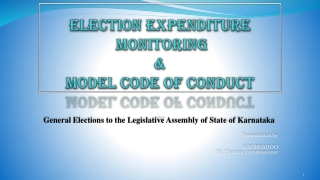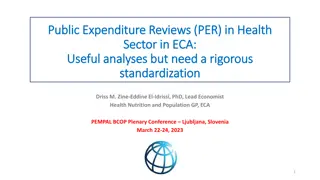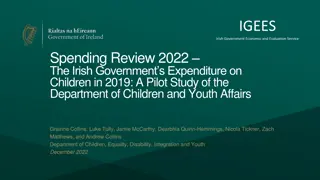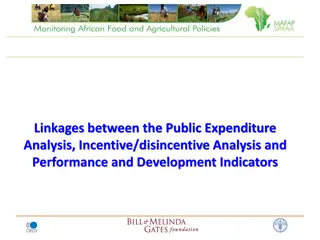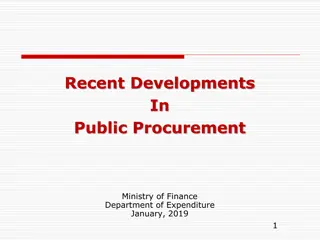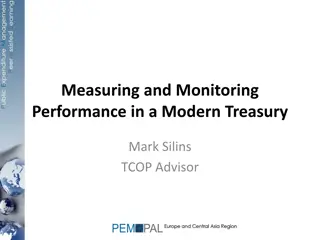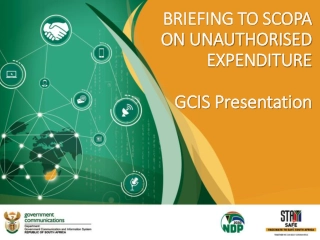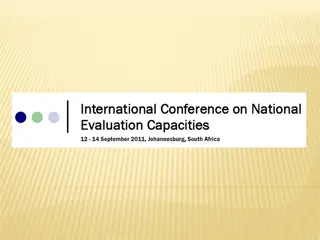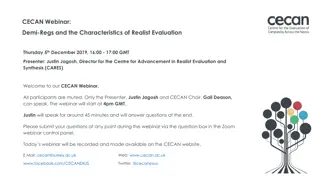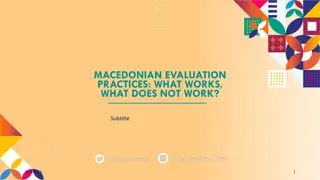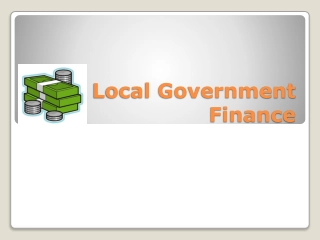Public Expenditure Management and Performance Evaluation
This content discusses the importance of Public Expenditure Review (PER) as a core diagnostic tool in evaluating government finances and guiding spending decisions. It emphasizes the analysis of public expenditures over time to align with policy priorities and achieve desired outcomes, highlighting the key areas of focus and sector breakdowns. The content also touches on the institutions involved in public expenditure management and presents case studies of reforms in enhancing public services and fiscal reforms across different priority areas.
- Public Expenditure Management
- Performance Evaluation
- Fiscal Policy
- Government Spending
- Policy Priorities
Download Presentation

Please find below an Image/Link to download the presentation.
The content on the website is provided AS IS for your information and personal use only. It may not be sold, licensed, or shared on other websites without obtaining consent from the author. Download presentation by click this link. If you encounter any issues during the download, it is possible that the publisher has removed the file from their server.
E N D
Presentation Transcript
Ivor Beazley Paris, November 6, 2019 PEMPAL BUDGET COP
Scope and focus areas macro, sectors, themes Comparison with Spending Reviews in OECD. Process and analytical methods Good practices and limitations PER basics, objectives, types etc. 2
PER is a core WB diagnostic tool whose purpose is to evaluate the effectiveness of public finances and inform future government spending decisions. PER is a highly flexible tool which responds to the government concerns and priorities in respect of both public spending and revenues. PER analyzes government expenditures over a period of years to assess consistency with policy priorities and the results achieved. 3
Institutions for Public Expenditure Management Institutions for Public Expenditure Management Macro Framework Macro- -fiscal Framework fiscal Sector Spending Sector Spending Impact Poverty, Equity Impact Growth, Poverty, Equity Growth, Efficiency Efficiency Effectiveness Effectiveness 4
The ECA region appeared to be the largest host of fiscally centered reports, while EAP delivered more than half of the total sector reviews (mainly for Indonesia). Breakdown of PERs by region and sector 30 26 24 25 1 20 2 20 2 11 0 3 15 Within the sector selection, the lion's share of the reports were attributed to social sectors education or/and health care (38%) followed by social protection (30%) and agriculture (20%) 4 8 10 7 19 1 0 1 11 1 3 5 2 6 0 5 0 0 2 1 0 1 0 0 AFR EAP ECA LCR MNA SAR Fiscally centered Civil Service Environment Agriculture Education&Health Security 5
Data sharing and analysis of options Government WB Dialogue Report Scope definition Implementation recommendations 6
PER 2, 2013. Reforms to enhance the quality of key public services in a fiscally constrained environment PER 1, 2011. Fiscal reform options across 3 priority areas of the budget A sustainable pension system Intergovernmental fiscal relations Spending in the education and health sectors Better targeted social assistance Rationalization of energy and agricultural subsidies. 7
2013 2014 Tajikistan PPER Tajikistan PPER Government Expenditures: Size, Composition and Trends, Key Issues in Public Finance Management Fiscal Risks from State-Owned Enterprises Health expenditures Education expenditures Capital Expenditures Public Investment Management. 8
COST DISTRIBUTION (1000 USD) COST DISTRIBUTION (1000 USD) 14 12 10 8 6 4 2 0 100 200 300 400 500 600 700 800 900 1000 9
Macroeconomic trends and context Analysis of fiscal stance (revenue, debt, expenditures) Analysis of fiscal risks Review of fiscal rules Areas to increase or decrease spending in order to boost growth and reduce inequality. 10
Fiscally focused PER incorporating fiscal policy review, covering both revenue and expenditures, including recommendations on: increasing government spending overall and higher taxation reforming the tax regime for the mining sector, changes in customs regime (e.g. presumptive to ad-valorem) reform of SME taxation. tax administration reforms, including risk based audit of corporate tax returns measures to improve efficiency and effectiveness of spending on health and education increased spending on infrastructure 11
Economic sectors - stand alone PER or part of multi-sector PER Focus on spending efficiency, effectiveness with a focus on poverty and equity in service provision Recommendations mostly relate to changes in policy, operations, and strategic shifts in resource allocation, rather than quantification of changes in allocations Example: Moldova Education PER (2018) 13
Examples of recommendations: Reform the financing mechanisms for vocational and higher education, to increase transparency Introduce per capita based financing for pre-school education Move the mandate for pre-school provision from municipalities to raions Review HRM processes to address bottlenecks in recruitment, retention, and performance. 14
Budget institutions and PFM reform Public investment management Revenue administration Debt management Control of quasi-fiscal activities and contingent liabilities Inter-governmental fiscal relations and decentralization 15
Incidence analysis of public spending (esp. education and health), often combined with analysis of private expenditures (e.g. in health and education) Incidence analysis of taxes Geographical equity i.e. comparing budget per capita across local government, rural/urban Access to and affordability of basic services (e.g. education and health, power and water) Analysis of efficiency/effectiveness of social transfer programs and consumer subsidies Gender aspects of inequality 16
Computable General Equilibrium (CGE) models, assess the impact of fiscal reforms on growth, poverty, inequality. Benchmarking of costs, spending, efficiency and effectiveness Regression analysis using budget and survey data Data envelope analysis (DEA), e.g. to assess efficiency of education spending in relation to educational outcomes data Public expenditure tracking surveys (PETS) 18
The current visualization takes the entire population of investment projects (~15 000) and displays it on the country map following the exact GEO location of sub-national jurisdiction Break this information by sectors, sub-sectors, programs, etc Share your budget stories Source: Albania GEO-BOOST government expenditure database. 20
Interesting findings often come from integration of budget data and household survey data. Show effects of policy and spending changes on inequality: E.g. Georgia, poverty reduction effects of public pension E.g. Uruguay, 13: impact of social spending on inequality (Gini) and poverty (Headcount Ratio) Jordan, 13: Distributional Impact of electricity tariff and consumer subsidy reforms 23
Integrate budget data and private sector survey data: Belarus: Effectiveness of state support to agriculture - effects of subsidies on firms performance/productivity Armenia: regression analysis of the data on the largest taxpayers to estimate unevenness in VAT compliance Azerbaijan: Impact of subsidies to farmers on productivity in agriculture 24
Use of Geographical Information System (GIS) for analysis of school location, which then was utilized to assess efficiency of educational investments Rasch analysis technique to assess impact of School Based Management implementation Estimates of economic return of public expenditures, NPV-based in agriculture (rural roads, irrigation, and extension) Regression analysis to estimate the economy of scale in public spending (across local governments) e.g. Belarus (2013) 25
Scenario analysis: modelling policy options Fiscal impact of specific government reform proposals E.g. Serbia 2015 Armenia, 2012: assessing fiscal impact of the new gov s pay initiatives 26
A typical BOOST is a repository of public expenditure/revenue data at the most detailed level of disaggregation available in the country s Treasury System The BOOST framework draws on a line-item budget representation and exhausts all budgeting dimension as envisaged in the CoAs/national budget classification BOOST operates through a PivotTable interface that permits practitioners to easily manipulate large amounts of data for high-quality multi-dimensional public expenditure analysis As a result, technical and non-technical experts are empowered to make evidence-based decisions that ultimately promote transparency and openness in development.. Resulting BOOST interface Process Input Treasury Data 28
Property tax collections averaged ~24% in overall locally derived own source revenue of municipalities, according to 2017 revenue budget execution data via BOOST. 3 out 61 municipalities accounted for more than 50% of the overall property tax collections. With the municipality of Tirana being responsible for 42.22% of all property tax collections. 29
Improve expenditure efficiency Improve expenditure efficiency Economy term budget cuts Economy - - short term budget cuts short Policy and operational improvements Policy and operational improvements Realign spending with government priorities Realign spending with government priorities WB PER OECD Spending Review 30
Comprehe nsive sectors Comprehe nsive all sectors Sectors Sectors Macro fiscal Macro fiscal Budget institutions and processes Budget institutions and processes Efficiency Efficiency Effectiveness Effectiveness Economy Economy Poverty and equity impact Poverty and equity impact all PER SR 31
Poverty/inequality focus using data integration Programmatic approach - context driven focus, Coverage of both national and subnational government, Focus on variability in spending and performance across local governments, Geo-spatial comparisons, and benchmarking Use of BOOST for rapid analysis 32
Availability of good survey data e.g. household data to support analysis of spending efficiency and effectiveness Implementation of recommendations depends on government (may inform DPO triggers). Political economy incentives and obstacles to change. Timeliness in relation to the budget decision making process. 33
